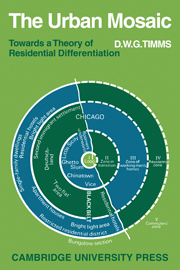Book contents
4 - Residential differentiation and social change
Published online by Cambridge University Press: 05 January 2012
Summary
It is characteristic of much work in urban ecology that while the fact of urban expansion is taken for granted, little attention is paid to other aspects of social or cultural change taking place in the wider society. All too frequently the urban community is taken as a phenomenon sui generis and considered in isolation. The hallmark of the macro-social approach to the study of residential differentiation within the city is that it attempts a rapprochement between urban ecology and the wider study of socio-cultural change. In the process an attempt is made to relate the bases of residential differentiation to the process of modernization.
Classical human ecology is a product of early twentieth-century Chicago. It is perhaps more than coincidental that the initial stimulus to the macrosocial approach to urban phenomena is a product of the burgeoning midtwentieth- century cities of the American West Coast, cities which have frequently been hailed as the harbingers of the ‘new urbanization’. There is an implicit assumption in much of the work produced under the aegis of classical human ecology that in some way the Chicago of the 1920s represents the typical case of the urban community. The experiences of the new communities of the West Coast and the growth of a comparative perspective in the social sciences, a development greatly speeded by the Second World War, have undermined the simplistic assumption that any single city can be typical of urban society and have caused a more searching inquiry to be made of the socio-cultural matrix in which urban communities are embedded.
- Type
- Chapter
- Information
- The Urban MosaicTowards a Theory of Residential Differentiation, pp. 123 - 210Publisher: Cambridge University PressPrint publication year: 1971

